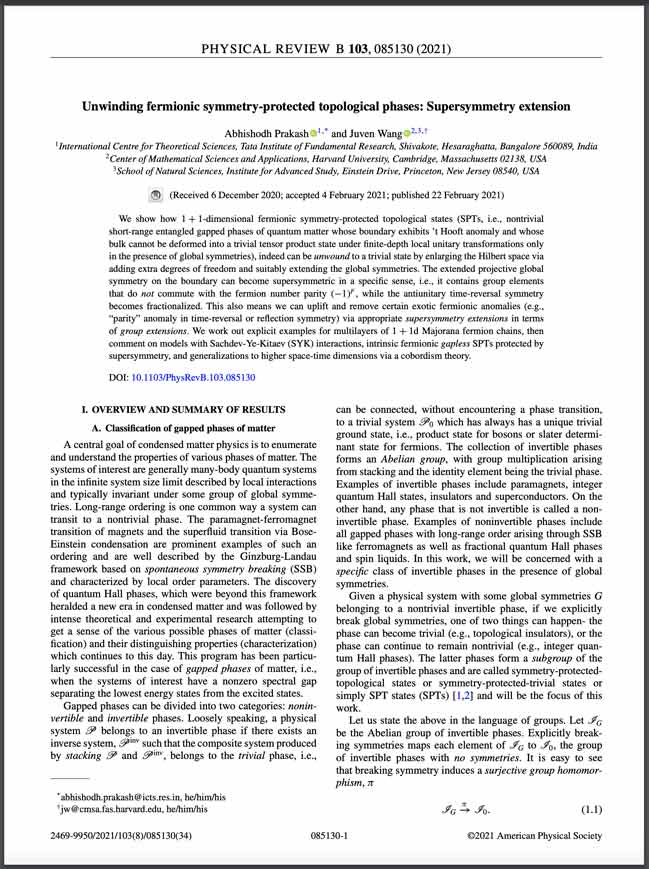

Unwinding Fermionic SPT Phases: Supersymmetry Extension
Abhishodh Prakash, Juven Wang
DOI: 10.1103/PhysRevB.103.085130
We show how 1+1-dimensional fermionic symmetry-protected topological states (SPTs, i.e. nontrivial short-range entangled gapped phases of quantum matter whose boundary exhibits ‘t Hooft anomaly and whose bulk cannot be deformed into a trivial tensor product state under finite-depth local unitary transformations only in the presence of global symmetries), indeed can be unwound to a trivial state by enlarging the Hilbert space via adding extra degrees of freedom and suitably extending the global symmetries. The extended projective global symmetry on the boundary can become supersymmetric in a specific sense, i.e., it contains group elements that do not commute with the fermion number parity (-1)F, while the anti-unitary time-reversal symmetry becomes fractionalized. This also means we can uplift and remove certain exotic fermionic anomalies (e.g., “parity” anomaly in time-reversal or reflection symmetry) via appropriate supersymmetry extensions in terms of group extensions. We work out explicit examples for multi-layers of 1+1d Majorana fermion chains, then comment on models with Sachdev-Ye-Kitaev (SYK) interactions, intrinsic fermionic gapless SPTs protected by supersymmetry, and generalizations to higher spacetime dimensions via a cobordism theory.
Higher-Rank Tensor Non-Abelian Field Theory: Higher-Moment or
Subdimensional Polynomial Global Symmetry, Algebraic Variety,
Noether’s Theorem, and Gauging
Juven Wang, Kai Xu, Shing-Tung Yau

DOI: https://doi.org/10.1103/PhysRevResearch.2.043219
With a view toward a fracton theory in condensed matter, we introduce a higher-moment polynomial degree-p global symmetry, acting on complex scalar/vector/tensor fields (e.g., ordinary or vector global symmetry for p=0 and p=1 respectively). We relate this higher-moment global symmetry of n-dimensional space, to a lower degree [either ordinary or higher-moment, e.g., degree-(p-â„“)] subdimensional or subsystem global symmetry on layers of (n−ℓ)-submanifolds. These submanifolds are algebraic affine varieties (i.e., solutions of polynomials). The structure of layers of submanifolds as subvarieties can be studied via mathematical tools of embedding, foliation, and algebraic geometry. We also generalize Noether’s theorem for this higher-moment polynomial global symmetry. We can promote the higher-moment global symmetry to a local symmetry and derive a new family of higher-rank-m symmetric tensor gauge theory by gauging, with m=p+1. By further gauging a discrete ZC2 charge conjugation (particle-hole) symmetry, we derive a general class of rank-m tensor non-Abelian gauge field theory (the gauge structure is noncommutative thus non-Abelian but not an ordinary group): a hybrid class of (symmetric or nonsymmetric) higher-rank-m tensor gauge theory and antisymmetric tensor topological field theory, generalizing Wang and Xu [Ann. Phys. 424, 168370 (2021)], interplaying between gapless and gapped sectors.
